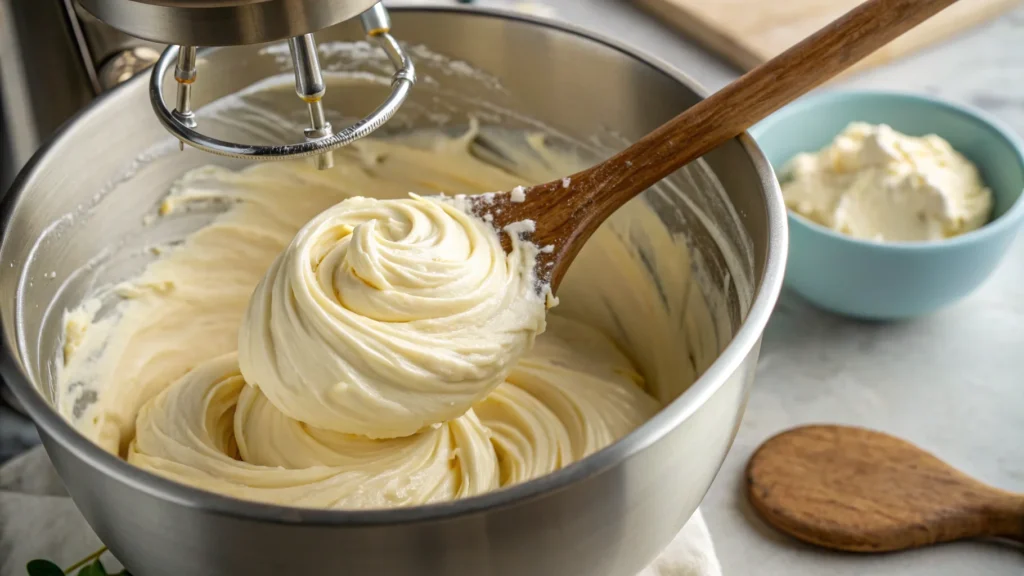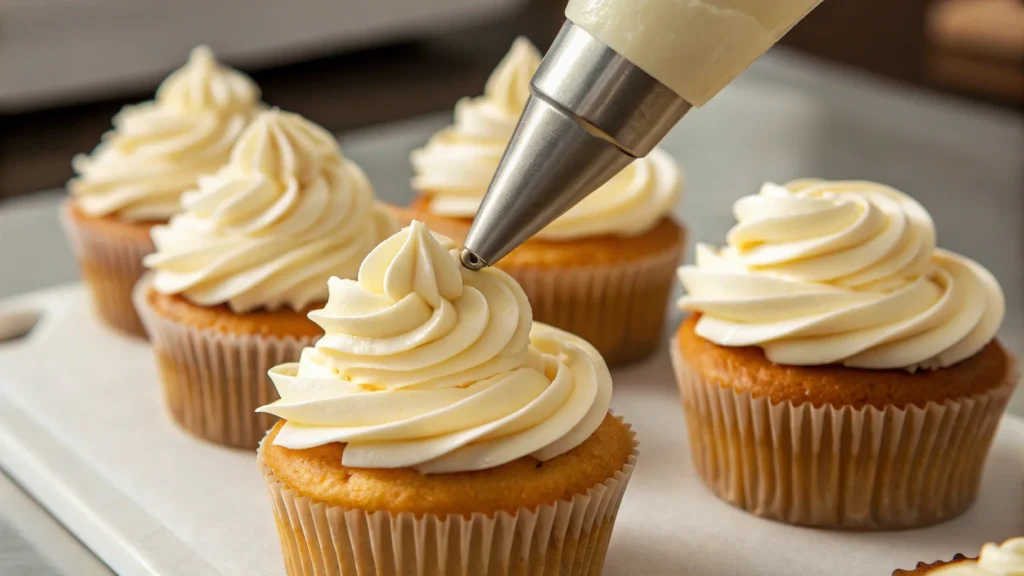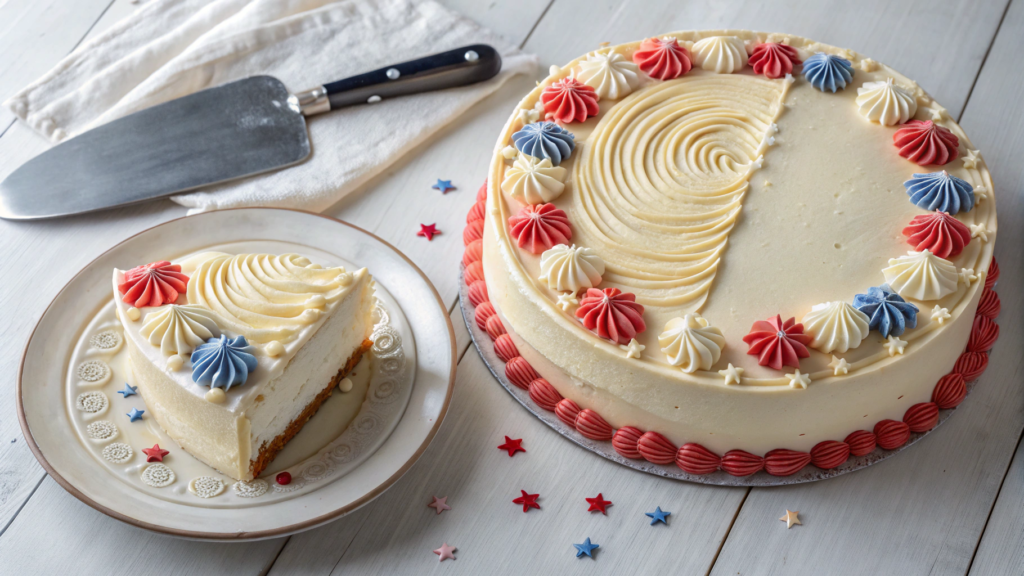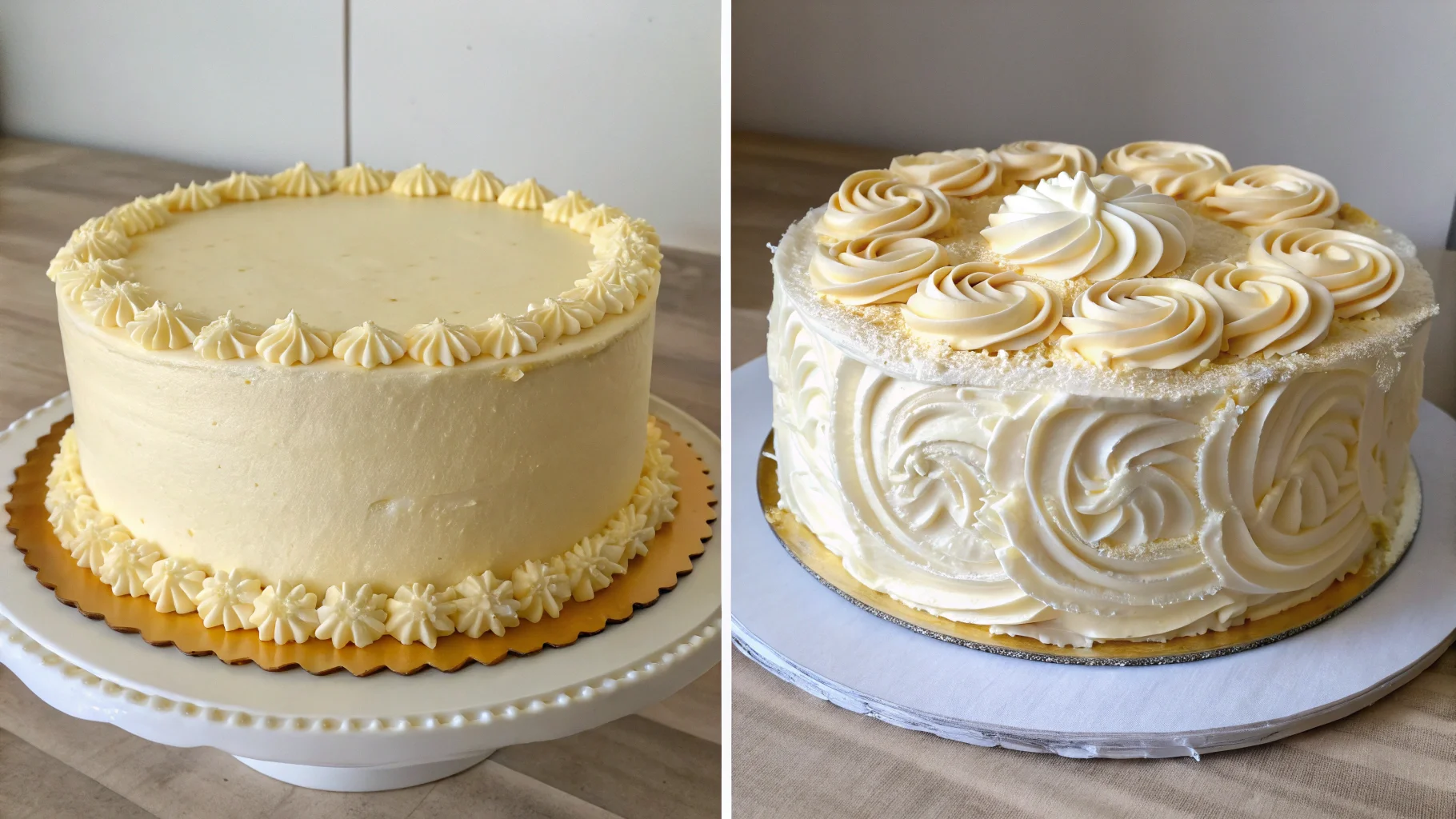Frosting is the heart of cake decorating, and buttercream reigns supreme. Whether you’re a home baker or a professional cake artist, choosing the right buttercream can make or break your dessert. But with so many types available, it’s easy to get lost in the creamy, sugary world of frostings.
One of the most debated topics in the baking community is Russian Buttercream vs. regular buttercream. What sets them apart? Is one better than the other? And which one should you use for your next cake?
In this guide, we’ll break down everything you need to know about these two popular frostings. We’ll explore their ingredients, textures, stability, and best uses. By the end, you’ll know exactly which buttercream fits your baking needs.
Table of contents
- Introduction to Buttercream Frosting
- What is Russian Buttercream?
- What is Regular Buttercream?
- Key Differences Between Russian Buttercream and Regular Buttercream
- Pros and Cons of Russian Buttercream vs. Regular Buttercream
- When to Use Russian Buttercream vs. Regular Buttercream
- How to Make Russian and Regular Buttercream
- FAQ
- Conclusion and Final Thoughts
Introduction to Buttercream Frosting
Buttercream is the go-to frosting for cakes, cupcakes, and pastries. But did you know that not all buttercreams are the same? From American Buttercream to Swiss Meringue Buttercream, each type has its unique qualities.
What is Buttercream?
Buttercream is a type of frosting primarily made from butter and sugar. It’s loved for its creamy texture, smooth consistency, and ability to hold decorations. Depending on the type, it can be thick and sturdy or light and fluffy.
Why is Buttercream Important in Baking?
A cake without frosting is like a sky without stars—it just doesn’t shine! Buttercream plays a crucial role in:
- Enhancing flavor: A good buttercream complements the cake without overpowering it.
- Providing structure: Some buttercreams, like American Buttercream, form a crust, making them ideal for piping intricate designs.
- Sealing in moisture: A layer of buttercream keeps cakes from drying out, ensuring they stay soft and delicious.
Overview of Different Types of Buttercream
Not all buttercreams are created equal. Here are some of the most common types:
- American Buttercream (ABC): The simplest and sweetest, made with butter and powdered sugar.
- Swiss Meringue Buttercream (SMBC): Light, silky, and less sweet, made with egg whites and sugar syrup.
- Italian Meringue Buttercream (IMBC): Similar to SMBC but more stable due to the hot sugar syrup.
- French Buttercream: Rich and custard-like, made with egg yolks instead of whites.
- Ermine Buttercream: Also called boiled milk frosting, this old-fashioned buttercream uses flour and milk for a smooth, whipped texture.
- Russian Buttercream: The simplest of the “true buttercreams,” made with just butter and sweetened condensed milk.
Each buttercream has its strengths, and the right one depends on what you’re looking for—flavor, stability, ease of use, or sweetness level.

What is Russian Buttercream?
Russian Buttercream is one of the simplest yet most delicious buttercreams you can make. Unlike traditional buttercreams that rely on powdered sugar or cooked syrups, Russian Buttercream is made with just two main ingredients: butter and sweetened condensed milk. This gives it a silky, rich texture with a slight caramelized sweetness.
Origins and History of Russian Buttercream
While the exact origins of Russian Buttercream aren’t well documented, it’s believed to have gained popularity in Eastern Europe. Many home bakers love it because it requires no eggs, no complicated cooking techniques, and only a few ingredients. Its simplicity makes it an ideal choice for quick desserts.
Key Ingredients and Their Roles
The secret to Russian Buttercream’s smooth consistency lies in its ingredients:
- Butter: The backbone of the frosting, providing a rich and creamy texture.
- Sweetened Condensed Milk: Adds sweetness, stability, and a hint of caramel flavor.
Unlike other buttercreams, Russian Buttercream contains no powdered sugar or egg whites, which makes it smoother and less grainy.
How Russian Buttercream is Made
Making Russian Buttercream is incredibly easy. Here’s a quick breakdown:
- Soften the butter until it’s light and fluffy.
- Slowly add the sweetened condensed milk while whipping to create a smooth emulsion.
- Whip until silky and spreadable—and that’s it!
There’s no need for a double boiler, sugar syrups, or egg whites. This makes it one of the fastest buttercreams to prepare.
Unique Characteristics of Russian Buttercream
So, what makes Russian Buttercream stand out?
- Smooth and creamy: Thanks to the condensed milk, there’s no graininess.
- Not overly sweet: Compared to American Buttercream, it has a more balanced sweetness.
- Quick and easy: With just two ingredients, it’s one of the simplest frostings to make.
- Rich and buttery flavor: Since it’s mostly butter, it has a strong dairy-forward taste.
Although Russian Buttercream is delicious and easy to make, it does have some limitations—especially in warm weather. But how does it compare to regular buttercream? Let’s take a look.
What is Regular Buttercream?
Now that we understand Russian Buttercream, let’s explore what’s considered “regular” buttercream. In baking, regular buttercream often refers to the most commonly used types, such as American Buttercream, Swiss Meringue Buttercream, Italian Meringue Buttercream, French Buttercream, and Ermine Buttercream. Each of these has its own unique characteristics and preparation methods.
Definition of “Regular” Buttercream
The term regular buttercream typically refers to butter-based frostings that contain sugar, butter, and sometimes eggs or milk. Unlike Russian Buttercream, these frostings can range from dense and sweet to light and airy, depending on how they’re made.
Different Types of Traditional Buttercream
There are several types of buttercream, each with distinct textures and flavors.
American Buttercream (ABC)
- Made with butter, powdered sugar, and a little milk or cream.
- The sweetest and thickest buttercream.
- Easy to make but can be grainy.
Swiss Meringue Buttercream (SMBC)
- Made by heating egg whites and sugar, then whipping them into a meringue before adding butter.
- Lighter, less sweet, and ultra-smooth.
Italian Meringue Buttercream (IMBC)
- Similar to Swiss Meringue but uses a hot sugar syrup instead of heating egg whites.
- More stable than Swiss Meringue and holds up well in warm conditions.
French Buttercream
- Made with egg yolks, giving it a rich and custard-like texture.
- Creamy but softer than other buttercreams.
Ermine Buttercream
- Made with a cooked flour-and-milk paste mixed with butter and sugar.
- Less sweet and very smooth, similar to whipped cream.
Common Ingredients in Regular Buttercreams
Most regular buttercreams share a common base of ingredients:
- Butter – The main fat component, providing richness and stability.
- Sugar – Either powdered sugar (American Buttercream) or granulated sugar dissolved in meringue (Swiss, Italian, and French Buttercreams).
- Eggs – Used in meringue-based buttercreams to create a smooth, airy texture.
- Milk or cream – Often added for extra creaminess.
Basic Preparation Methods
The preparation of regular buttercream depends on the type:
- American Buttercream is made by simply beating butter and powdered sugar together.
- Swiss and Italian Meringue Buttercreams require heating egg whites and sugar, then whipping into a fluffy meringue before adding butter.
- French Buttercream involves whisking egg yolks while slowly adding hot sugar syrup.
- Ermine Buttercream starts by cooking a milk-and-flour paste before blending it into whipped butter.
These methods make regular buttercream more versatile but often more time-consuming than Russian Buttercream.

Key Differences Between Russian Buttercream and Regular Buttercream
When deciding between Russian Buttercream and regular buttercream, it’s essential to compare their texture, taste, stability, and ease of use. So, what is the difference between Russian Buttercream and regular buttercream? Let’s break it down.
Ingredient Comparison
The biggest difference lies in the ingredients.
- Russian Buttercream: Made with just butter and sweetened condensed milk.
- Regular Buttercream: Usually contains butter, sugar, eggs (in meringue-based versions), and sometimes milk or cream.
Since Russian Buttercream doesn’t use powdered sugar, it has a silkier texture without any graininess. On the other hand, American Buttercream relies heavily on powdered sugar, making it sweeter and denser.
Texture and Consistency Differences
The texture of each buttercream depends on how it’s made.
- Russian Buttercream: Super smooth, creamy, and slightly softer than other buttercreams.
- American Buttercream: Thick, dense, and often slightly grainy due to powdered sugar.
- Swiss and Italian Meringue Buttercreams: Light, fluffy, and airy due to whipped egg whites.
- French Buttercream: Rich and custard-like because of the egg yolks.
If you prefer a buttercream that melts in your mouth without being overly stiff, Russian Buttercream is a great option.
Sweetness and Flavor Profile
The sweetness level varies significantly.
- Russian Buttercream: Less sweet, with a distinct buttery and caramel-like flavor from the condensed milk.
- American Buttercream: The sweetest of all, as it’s mostly sugar and butter.
- Swiss & Italian Meringue Buttercreams: Balanced sweetness with a light and airy taste.
- French Buttercream: Very rich, with a slight custard flavor.
For those who dislike overly sugary frosting, Russian Buttercream or Swiss Meringue Buttercream would be better choices.
Stability and Durability
How well buttercream holds up depends on temperature and structure.
- Russian Buttercream: Holds up well at cool room temperatures but melts easily in warm conditions since it’s mostly butter.
- American Buttercream: Forms a crust, making it great for decorating and piping.
- Swiss and Italian Meringue Buttercreams: More stable than Russian Buttercream but require refrigeration.
- French Buttercream: Soft and delicate, not ideal for piping intricate details.
If you need a buttercream for intricate decorations, American Buttercream or Swiss Meringue Buttercream are better choices. But if you’re after an easy, smooth frosting, Russian Buttercream wins.
Ease of Preparation
- Russian Buttercream: The easiest to make—just whip butter and condensed milk!
- American Buttercream: Also easy but can require adjustments to balance sweetness.
- Meringue Buttercreams (Swiss, Italian, French): More complicated, involving cooking sugar or eggs.
If you’re short on time, Russian Buttercream is the quickest and simplest option.
Pros and Cons of Russian Buttercream vs. Regular Buttercream
Now that we know the differences, let’s break down the pros and cons of each buttercream to help you decide which one suits your baking needs best.
Advantages of Russian Buttercream
✅ Smooth and creamy texture – No grainy sugar granules.
✅ Less sweet – Perfect for those who don’t like overly sugary frostings.
✅ Super easy to make – Just two ingredients and no cooking!
✅ Pairs well with delicate cakes – Works beautifully with sponge and chiffon cakes.
Disadvantages of Russian Buttercream
❌ Not as stable in warm weather – Can melt quickly in high temperatures.
❌ Limited flavor customization – Harder to adjust sweetness without altering the texture.
❌ Less structure for piping intricate designs – Best for simple cake finishes.
Advantages of Regular Buttercream
✅ More stable for decorations – American and Meringue Buttercreams hold shape well.
✅ Versatile flavors – Can be flavored easily with extracts, fruit purees, and chocolate.
✅ Works well in warm conditions – Some variations (like American Buttercream) can hold up in heat.
✅ Great for piping – Best choice for detailed cake decorations.
Disadvantages of Regular Buttercream
❌ Can be too sweet – Especially American Buttercream, which is very sugar-heavy.
❌ More complex to make – Meringue-based buttercreams require cooking and precision.
❌ Some types can be grainy – American Buttercream, if not mixed properly, may feel gritty.

When to Use Russian Buttercream vs. Regular Buttercream
Choosing the right buttercream depends on several factors, including the type of cake, decorating needs, and even the weather. So, what is the difference between Russian Buttercream and regular buttercream when it comes to practical use? Let’s explore when to choose each one.
Best Cakes for Russian Buttercream
Because of its rich, buttery flavor and smooth texture, Russian Buttercream works best with cakes that are light and delicate. Here are some great pairings:
- Sponge cakes – The airy texture of sponge cakes balances the creamy richness of Russian Buttercream.
- Chiffon cakes – Since Russian Buttercream is less sweet, it complements the mild flavors of chiffon cakes.
- Tres leches cakes – This soft, milk-soaked cake pairs beautifully with the smooth, milky taste of Russian Buttercream.
- Butter cakes – If you love a buttery, melt-in-your-mouth texture, this is a great match.
However, Russian Buttercream isn’t ideal for cakes that require a sturdy structure or heavy decoration since it’s quite soft and doesn’t hold up well in warm temperatures.
Best Cakes for Different Types of Regular Buttercream
Since regular buttercream includes a variety of types, some work better than others depending on the cake.
- American Buttercream – Works best for birthday cakes, cupcakes, and layered cakes because it’s stable and pipes well.
- Swiss and Italian Meringue Buttercream – These are ideal for wedding cakes and tiered cakes since they are light, smooth, and stable.
- French Buttercream – Due to its custard-like consistency, it’s best for dessert cakes like opera cake or éclair fillings.
- Ermine Buttercream – This is a great choice for red velvet cake since it has a light, whipped texture and a balanced sweetness.
Which Buttercream Works Best for Decorating?
If you’re planning to pipe intricate designs, flowers, or sharp-edged cakes, Russian Buttercream may not be the best choice. It’s smooth and creamy but lacks the stiffness needed for detailed decorations.
Instead, American Buttercream is the most reliable for piping because it crusts over, allowing intricate shapes to hold. Swiss and Italian Meringue Buttercream are also good choices because they remain stable but don’t form a crust.
For simple naked cakes, rustic finishes, or smooth-textured cakes, Russian Buttercream is a fantastic choice because it spreads easily and looks naturally glossy.
Which Buttercream is Better for Warm Weather?
If you’re baking in a hot or humid climate, stability is a key factor.
- Russian Buttercream – Since it’s made mostly of butter, it melts quickly in heat and isn’t ideal for outdoor events.
- American Buttercream – Holds up better because the powdered sugar gives it more structure.
- Swiss and Italian Meringue Buttercream – More resistant to heat than Russian Buttercream but still softens at high temperatures.
- Ermine and French Buttercream – These are the least heat-stable options due to their milk or egg yolk base.
For warm conditions, American Buttercream is the safest choice, while Swiss or Italian Meringue Buttercream can also work if stored properly.
Now that we know when to use each buttercream, let’s learn how to make them!
How to Make Russian and Regular Buttercream
Now that we’ve explored their differences, let’s get hands-on and learn how to make both Russian Buttercream and regular buttercream.
Step-by-Step Guide to Making Russian Buttercream
Russian Buttercream is one of the easiest frostings to make. Follow these simple steps for a perfect, silky texture.
Ingredients:
- 1 cup (2 sticks) unsalted butter, softened
- ½ can (7 oz) sweetened condensed milk
- 1 tsp vanilla extract (optional)
Instructions:
- Whip the butter – Using a hand mixer or stand mixer, beat the softened butter on high speed for about 5 minutes until pale and fluffy.
- Slowly add condensed milk – Reduce the speed to low and gradually pour in the sweetened condensed milk, mixing continuously.
- Increase speed and whip – Once combined, turn the mixer to high and beat for another 3 minutes until smooth and silky.
- Add vanilla (optional) – Mix in the vanilla extract for extra flavor.
Pro Tips:
✅ If the buttercream looks curdled, keep whipping—it will smooth out.
✅ Make sure the butter is at room temperature before starting.
✅ Avoid overmixing, or the buttercream may become too soft.
Step-by-Step Guide to Making American Buttercream
Since American Buttercream is one of the most popular frostings, here’s a quick guide to making it from scratch.
Ingredients:
- 1 cup (2 sticks) unsalted butter, softened
- 4 cups powdered sugar
- 2-3 tbsp milk or heavy cream
- 1 tsp vanilla extract
- Pinch of salt
Instructions:
- Beat the butter – Whip the butter on medium-high speed for 2 minutes until light and creamy.
- Add powdered sugar gradually – Mix in the powdered sugar 1 cup at a time, beating on low to avoid a sugar cloud.
- Add milk or cream – Stir in 2 tablespoons of milk and beat on high for 2 more minutes until fluffy.
- Flavor it – Add vanilla extract and a pinch of salt. If too thick, add more milk; if too thin, add more sugar.
Pro Tips:
✅ Sift the powdered sugar before mixing to prevent graininess.
✅ If you need a firmer buttercream for piping, use less liquid.
✅ For a whiter buttercream, use clear vanilla extract.
Step-by-Step Guide to Making Swiss Meringue Buttercream
Swiss Meringue Buttercream is light, silky, and less sweet than American Buttercream. Here’s how to make it.
Ingredients:
- 4 egg whites
- 1 cup granulated sugar
- 1 ½ cups (3 sticks) unsalted butter, softened
- 1 tsp vanilla extract
Instructions:
- Heat the egg whites and sugar – Place them in a heatproof bowl over simmering water. Whisk constantly until the sugar dissolves.
- Whip the meringue – Transfer to a mixer and beat on high speed until stiff peaks form.
- Add butter gradually – Reduce the speed and add softened butter a little at a time.
- Mix until smooth – If it looks curdled, keep mixing—it will come together.
Pro Tips:
✅ Use a thermometer to ensure the egg whites reach 160°F for food safety.
✅ If the buttercream is too soft, chill it briefly before whipping again.
Each buttercream has its own unique texture, flavor, and use case, so choosing the right one depends on what you need for your cake.
FAQ
When comparing buttercreams, many bakers have similar questions. Below, we’ll answer some of the most common ones to help you decide which frosting works best for your needs.
Is Russian Buttercream Healthier Than Regular Buttercream?
Not necessarily. While Russian Buttercream has fewer ingredients, it is still high in butter and sugar. However, since it contains sweetened condensed milk instead of powdered sugar, it may be slightly lower in sugar than American Buttercream. If you’re looking for a lighter option, Swiss or Italian Meringue Buttercream may be better, as they have less sugar and more protein from egg whites.
Can I Substitute Sweetened Condensed Milk in ?
No, sweetened condensed milk is essential for Russian Buttercream. It acts as both the sweetener and stabilizer. Substituting evaporated milk or regular milk won’t work because they lack the necessary sugar content and thickness. If you need a different buttercream without condensed milk, consider Swiss Meringue or Ermine Buttercream.
Which Buttercream is Best for Piping Decorations?
If you want a buttercream that holds its shape for detailed piping, American Buttercream is the best choice. It crusts slightly, making it perfect for intricate designs. Swiss and Italian Meringue Buttercreams are also good for piping but won’t hold sharp details as well as American Buttercream. On the other hand, Is too soft for intricate decorations but works well for smooth frosting applications.
Does it Hold Up in Warm Weather?
Not really. Since Russian Buttercream is mostly butter, it melts quickly in warm or humid conditions. If you need a buttercream that withstands heat, American Buttercream is the most stable. Swiss and Italian Meringue Buttercreams are also better suited for warm weather, but they should be kept cool when possible.
Now that we’ve answered the most common questions, let’s wrap up with some final thoughts!
Conclusion and Final Thoughts
So, what is the difference between Russian and regular buttercream? The answer depends on what you need for your cake.
Summary of Key Differences
Here’s a quick recap of what makes each buttercream unique:
- Russian Buttercream is smooth, creamy, and less sweet, with a strong buttery taste. It’s quick and easy to make but lacks structure for intricate designs.
- American Buttercream is sweet, dense, and sturdy, making it the best for decorating. However, it can be grainy and overly sweet.
- Swiss and Italian Meringue Buttercreams are light, silky, and balanced in sweetness, ideal for elegant cakes but require precise techniques.
- French Buttercream is rich and custard-like, perfect for gourmet desserts but too soft for heavy piping.
- Ermine Buttercream is fluffy and old-fashioned, great for red velvet cakes but less common in modern baking.
Which Buttercream is Right for You?
- If you want a quick, easy, and silky, go for Russian Buttercream.
- If you need strong structure for piping, American Buttercream is the best.
- If you prefer a light, professional-style buttercream, choose Swiss or Italian Meringue Buttercream.
- If you love rich and decadent frosting, French Buttercream is your best bet.
Both Russian Buttercream and regular buttercream have their advantages, so the right choice depends on your cake, climate, and personal taste. Try them out and see which one becomes your favorite!

